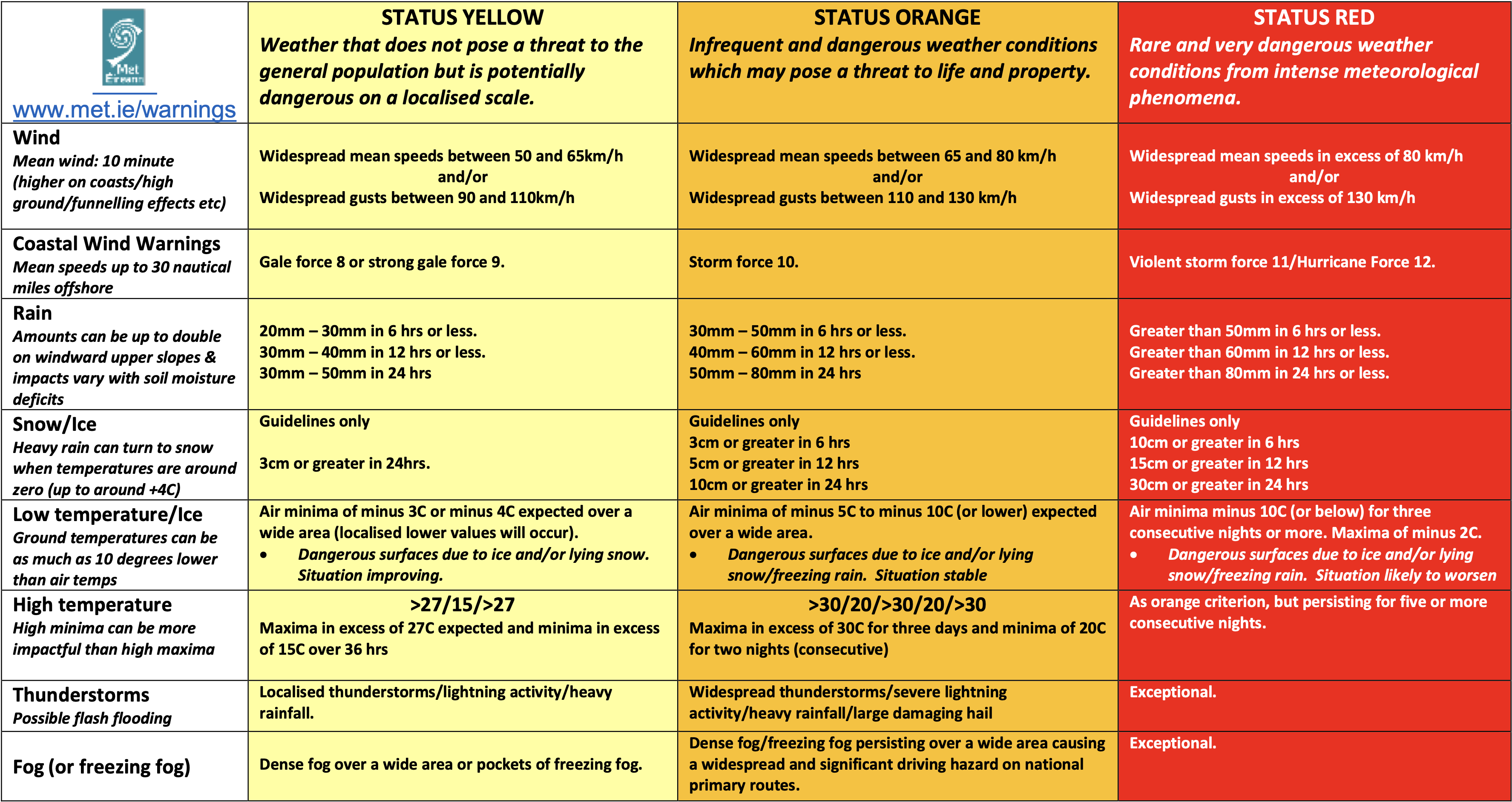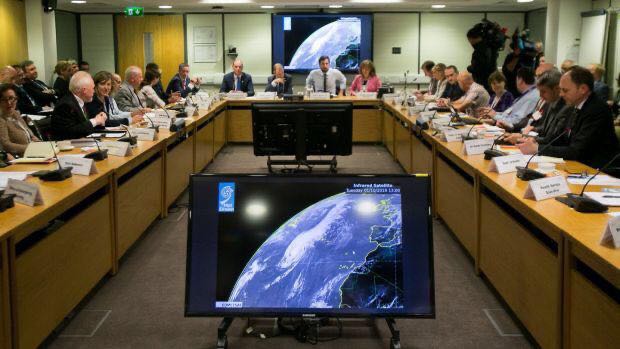Have you ever wondered how Met Éireann determine what status a weather warning should be issued under? We’ve taken the official explanation from Met Éireann’s website and included it below so that you can get a better understanding of how warnings are issued in Ireland.
Met Éireann is the Irish National Meteorological Service as recognised by the World Meteorological Organisation under an international convention since 1950 and one of its most important roles is to protect life and ensure citizen safety. The service also supports the activities of the citizen and other agencies to mitigate damage to property and reduce disturbance to economic activity and so enhance support for impact-based decision making for weather events.
Met Éireann’s main suite of warnings are issued by the duty forecaster between 10am and midday and are updated as necessary as new information becomes available. In general, warnings will not be issued more than 60-hours ahead of the expected adverse weather but advisories on potential hazards are issued up to a week in advance.
Impacts from wind/rain/snow etc., vary depending on location, recent weather conditions, the state of ground, the time of year as well as the duration of the event. In particular the timing and location of the occurrence of extreme weather can significantly affect the impact which extreme weather may have on society, or on the economy.
The colour coding used by Met Éireann is fully aligned with international best practice and the European Meteoalarm system (www.meteoalarm.eu)
| Yellow | Not unusual weather. Localised danger. |
| Orange | Infrequent. Dangerous / disruptive. |
| Red | Rare. Extremely dangerous / destructive. |
National Emergency Coordination Group (NECG)
Local Authorities are the lead agencies for co-ordinating the response to severe weather emergencies. Where weather emergencies are judged to impact public safety at national level the National Emergency Coordination Group (NECG) is activated by the Office of Emergency Planning on request from the Department of Housing, Local Government and Heritage. This is the Lead Government Department for weather emergencies.
Met Éireann provides the weather briefings at the NECG, which brings together all Government Departments and relevant agencies and organisations, to support the locally led response and ensure coordination across the “Whole-of-Government” for the duration of the emergency.
Weather Advisories
Weather Advisories are issued up to about a week ahead to provide early information on potential hazardous weather. They may also be employed when a sum of weather elements acting together create a significant hazard, e.g. winds which may not be up to warnings strength but which, when combined with high tides and significant swell, generate a risk of flooding. Another possible use would be to advise of wind speed and direction on occasions of Volcanic Ash contamination. They might also be used to advise of expected significant medium-term accumulations of rain during a very unsettled period, when soils are known to be saturated. The issue of Weather Warnings and Weather Advisories is at all times down to the judgement of the Met Éireann Meteorologists/Forecasters.
When Will The Weather Warnings Be Issued?
In general Weather Warnings will be issued whenever weather conditions meeting the detailed thresholds defined below are anticipated within a 60-hr period. There will be judgement required on the part of the forecaster who must weigh up the possible severity of the weather conditions and the likelihood of their occurrence. However on some occasions (weekends, holiday periods) it may be necessary to issue Weather Warnings beyond this 60-hr horizon, if sufficient certainty derives from examination of the weather charts. Normally, however, a Weather Advisory (see above) will be used to flag severe weather beyond 60 hrs and Advisories will normally anticipate only “Orange” or “Red” criteria weather hazards.
Given that the thrust of the Weather Warnings service is on potential “Impacts” of weather rather than on the numerical values attained by the weather elements themselves, it may on occasion be appropriate to issue warnings at a level higher than that strictly justified by the anticipated weather elements. An example would be when heavy rain was expected which might not quite meet the “Orange Warning” criteria but which might give rise to significant flooding because of already saturated ground, or because of a combination of rain, wind and tide in a coastal location.
Weather Warning Criteria
The criteria for the different warnings levels (Yellow, Orange, Red) and the different weather elements are laid out in the tables below.
IMPACT CONSIDERATIONS: These numerical criteria are strong guidelines but impacts from wind/rain/snow etc., vary depending on location, recent weather conditions, the state of ground, the time of year as well as the duration of the event. In any individual weather event, not every location in the warning area may experience the same degree of weather or impacts. When severe weather is expected, weather and impacts at lower levels are also likely to be experienced.
| STATUS YELLOWWeather that does not pose a threat to the general population but is potentially dangerous on a localised scale. Be aware about meteorological conditions and check if you are exposed to danger by nature of your activity or your specific location. Do not take any avoidable risks |
| Wind Mean speed: 10 minute Gust | Widespread mean speeds between 50 and 65km/h Widespread gusts between 90 and 110km/h |
| Coastal Wind Warnings Mean speeds up to 30 nautical miles offshore | Gale force 8 / Strong Gale Force 9 |
| Rain Amounts can be up to double on windward upper slopes & impacts vary depending on for example soil moisture deficits | 20mm – 30mm in 6 hrs or less 30mm – 40mm in 12 hrs or less 30mm – 50mm in 24 hrs |
| Snow/Ice | 3cm or more in 24 hours |
| Low Temperature/Ice | Air minima of minus 3C or minus 4C expected over a wide area (localised lower values will occur). Dangerous surfaces due to ice and/or lying snow. Situation improving. |
| High Temperature | >27/15/>27 Maxima over a wide area in excess of 27C (localised higher values will occur) and minima in excess of 15C |
| Thunderstorm | Thunderstorms/lightning activity/heavy rainfall/hail |
| Fog (or freezing fog) | Dense fog over a wide area or pockets of freezing fog |
| STATUS ORANGEInfrequent and dangerous weather conditions which may pose a threat to life and property. Prepare yourself in an appropriate way depending on location and activity. All people and property in the affected areas can be significantly impacted. Check your activity/event and delay or cancel as appropriate. |
| Wind Mean speed: 10 minute Gust | Widespread mean speeds between 65 and 80km/h Widespread gusts between 110 and 130km/h |
| Coastal Wind Warnings Mean speeds up to 30 nautical miles offshore | Storm Force 10 |
| Rain Amounts can be up to double on windward upper slopes & impacts vary depending on for example soil moisture deficits. | 30mm – 50mm in 6 hrs or less 40mm – 60mm in 12 hrs or less 50mm – 80mm in 24 hrs |
| Snow/Ice | 3cm or greater in 6 hrs 5cm or greater in 12 hrs 10cm or greater in 24 hrs |
| Low Temperature/Ice | Air minima of minus 5C to minus 10C (or lower) expected over a wide area. Dangerous surfaces due to ice and/or lying snow/freezing rain. Situation stable. |
| High Temperature | >30/20/>30/20/>30 Maxima in excess of 30C for three days and minima of 20C for two nights (consecutive). |
| Thunderstorm | Widespread thunderstorms/severe lightning activity/heavy rainfall/large damaging hail |
| Fog (or freezing fog) | Dense fog/freezing fog persisting over a wide area causing a widespread and significant driving hazard on national primary routes. |
| STATUS REDRare and very dangerous weather conditions from intense meteorological phenomena. Take action to protect yourself and your property. Follow instructions and advice given by the authorities under all circumstances and be prepared for exceptional measures. |
| Wind Mean speed: 10 minute Gust | Widespread mean speeds in excess of 80km/h Widespread gusts in excess of 130km/h |
| Coastal Wind Warnings Mean speeds up to 30 nautical miles offshore | Violent Storm Force 11 / Hurricane force 12 |
| Rain Amounts can be up to double on windward upper slopes & impacts vary depending on for example soil moisture deficits. | Greater than 50mm in 6 hrs or less Greater than 60mm in 12 hrs or less Greater than 80mm in 24 hrs or less |
| Snow/Ice | 10cm or greater in 6 hrs 15cm or greater in 12 hrs 30cm or greater in 24 hrs |
| Low Temperature/Ice | Air minima minus 10C (or below) for three consecutive nights or more. Maxima of minus 2C. Dangerous surfaces due to ice and/or lying snow/freezing rain. Situation likely to worsen. |
| High Temperature | As Orange criterion, but persisting for five or more consecutive days & nights. |
| Thunderstorm | Exceptional |
| Fog (or freezing fog) | Exceptional |
Help support Cork Safety Alerts by becoming a member – Click Here



